Highlights
- New IFS analysis: In general, activities with children score highest on well-being. Post This
- It's possible that those who forego kids in order to focus on their careers or social lives are actually limiting their happiness. Post This
- For almost all activity categories, respondents are more likely to assign the highest happiness rating when accompanied by their children. Post This
A few years ago, a Time Magazine cover on "the childfree life" featured a happy, beautiful couple relaxing on the beach by themselves. This image implied that life is happier without kids. It’s a common refrain we hear these days, whether from news articles, childfree advocates on social media, or movies. However, a new IFS analysis of the American Time Use Survey (ATUS) suggests something most parents already know—everyday activities are actually more enjoyable when children are present.
Well-Being Ratings Are Higher With Children
The 2021 ATUS collected data on U.S. adults' well-being ratings for certain tasks and whether their own household children were present at the time. I analyzed this data for adults ages 25 to 50 to learn how happiness and meaningfulness ratings vary by the presence of kids versus other individuals.1 In general, activities with children score highest on well-being. For instance, 56% of activity time2 receives the highest meaningfulness rating when children are present, whereas only 37% of time spent with other individuals does. Similarly, respondents are more3 likely to assign the highest happiness rating to time spent on activities with their kids (44%) than without (25%). Activities also have a higher probability of receiving the lowest pain, sadness, and stress scores when children are involved.
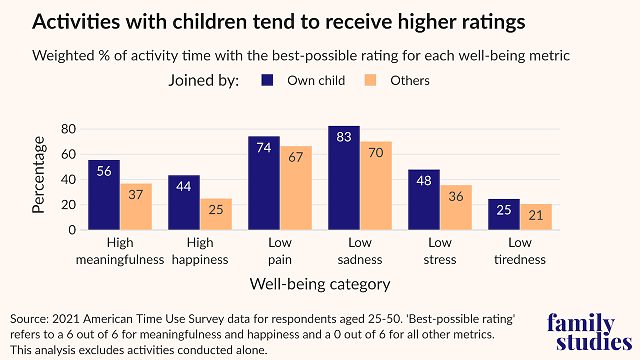
As every parent knows, spending time with children can often be exhausting. Interestingly, however, the percentage of activity time with the lowest rating for tiredness does not vary significantly by the presence of children.
Activities With Kids Are Generally Happier
One explanation for these findings could be that children are less likely to be present during less enjoyable activities. For instance, individuals report less happiness, along with a lower likelihood of having kids with them, when working than when socializing. Therefore, I also examined how happiness and meaningfulness ratings vary for specific activity categories4 when children were—and were not—present.
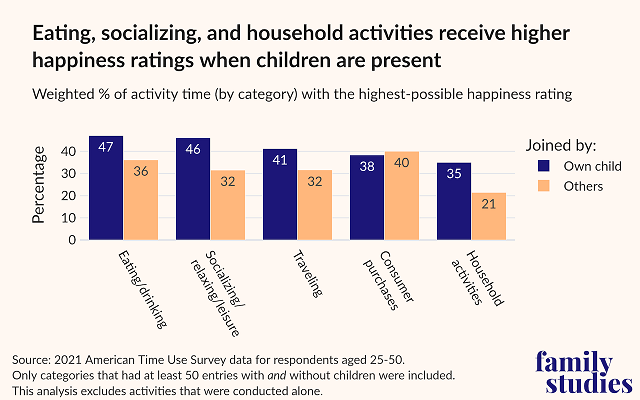
For almost all of these activity categories, respondents are more likely to assign the highest happiness rating when accompanied by their children. For instance, 47% of time in the “Eating and Drinking” category earns the highest happiness rating when children are present; meanwhile, only 36% of time spent dining with others does. In addition, 46% of “Socializing, Relaxing, and Leisure” time with children—but only 32% of time with other people—gets a 6 out of 6 rating for happiness. Thus, the couple on the Time Magazine cover may have had a better shot at a happy vacation if they were accompanied by a child of their own.
Children’s Presence Associated With Higher Meaningfulness
As previous IFS research has shown, being a parent—despite the stressors and challenges that come with raising children—is associated with greater meaning in life. This pattern was also evident in the ATUS data. Respondents are more likely to assign top meaningfulness ratings to the time they spend traveling, dining, socializing, and performing household activities (e.g. chores, food preparation, etc.) when their children are present than when others are.
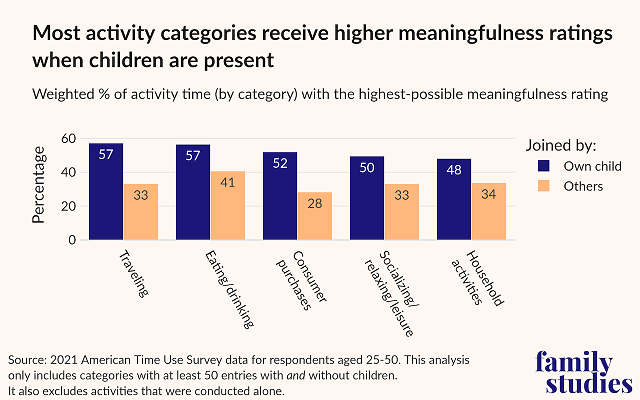
Time With a Spouse is Happier With Kids Present
Some fear that having children will result in less quality time with their husband or wife. However, as shown in the following graph, time with children is more likely to receive top happiness and meaningfulness scores than is time with one's spouse.5 In other words, even if parents are not able to get as much couple time in as before having kids, the gift of time with their kids may more than compensate.
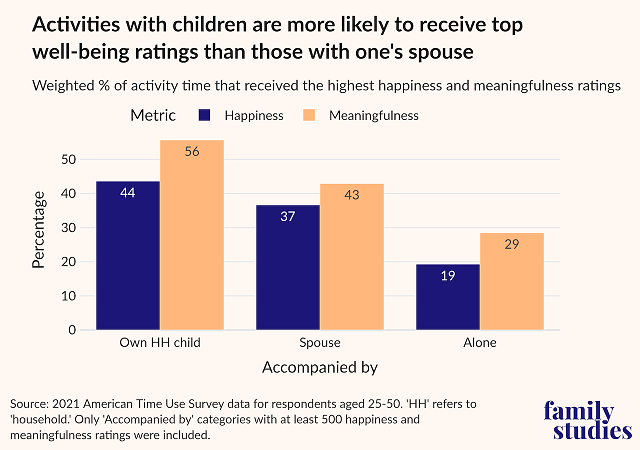
Parents may also find themselves yearning for the days when they could spend long, uninterrupted stretches of time by themselves. However, this chart also reveals that alone time is far less likely than time with kids to receive top happiness and meaningfulness ratings.
These findings do not mean that parents should put time with their kids above time with each other. After all, as shown in the following chart, 48% of time spent with one's child(ren) and spouse receives the top happiness rating—compared to only 40% of time spent with one or more children in the absence of a spouse.
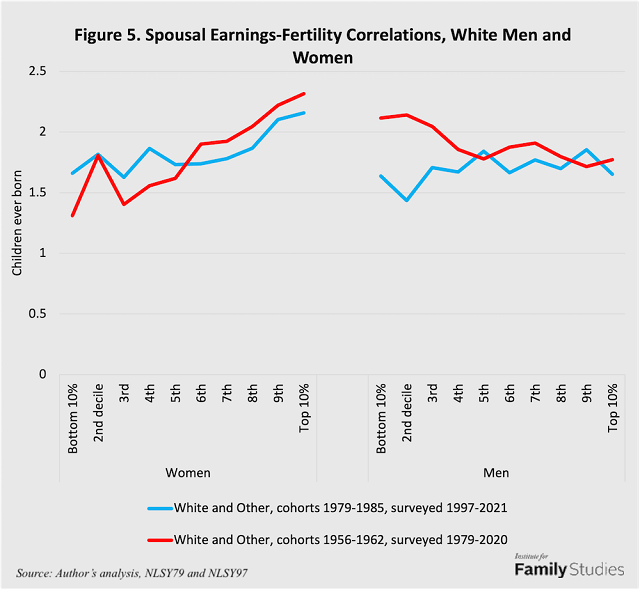
Caring for Others Receives High Well-Being Ratings
I also investigated which activity categories were the most likely to receive high happiness and meaningfulness scores. Time spent caring for household members is more likely to receive a high happiness rating (45%) than time spent socializing/relaxing (32%) or working (16%). Similarly, while around two-thirds of time spent caring for one's household is rated as highly meaningful, the same is true of only around one-third of work hours and leisure time.
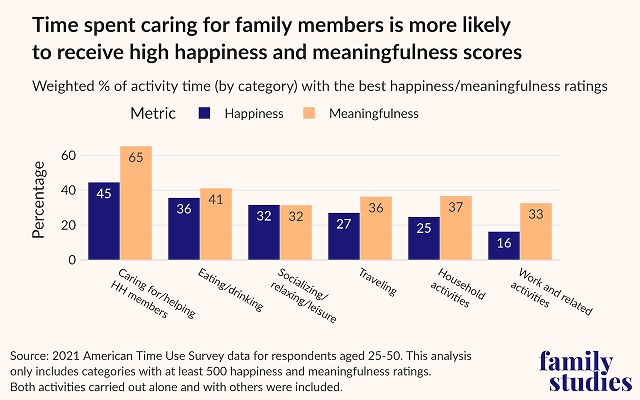
Life Is Better With Kids
This analysis indicates that activities are often happier and more meaningful when kids are around. This finding, along with the high happiness and meaningfulness ratings assigned to caring for one's household, calls into question the wisdom of the 'childfree' movement. It's possible that those who forego children in order to focus on their careers or social lives are actually limiting their happiness as a result.
However, these results do not prove that the presence of children directly increases well-being. Many other factors that influence both happiness and the choice to have kids, such as marriage and religion, could explain this relationship.
In addition, the well-being ratings for time with kids are based on individuals who chose to have their children with them during specific activities. The fact that this group is especially likely to report such activities as happy and meaningful does not prove that other people—such as 'childfree' influencers—would also enjoy the presence of children as much.
It is also important to note that this survey data was collected during the COVID-19 pandemic, a time when Americans were more isolated than usual. It's possible that the presence of children was particularly beneficial for individuals' well-being during that time, as respondents had fewer alternative options for social contact. It will be interesting to see whether these findings can be replicated within the next ATUS dataset that includes well-being ratings.
Yet, despite these limitations, these results should prove encouraging to those who are considering having kids but are afraid to give up their current lifestyle. The reality is that life with children is often more enjoyable.
Ken Burchfiel is a Research Fellow at the Institute for Family Studies.
1. When analyzing how happiness ratings varied by the presence of children, I excluded activities from the ATUS dataset that were carried out alone; that way, I could better compare how being with children compared to being with other individuals. (An exception to this rule was my comparison of happiness and meaningfulness ratings for time spent with kids, with spouses, and alone.) However, for analyses that did not compare ratings by the presence of children, I based my calculations on both activities conducted with others and on those carried out alone.
2. The percentages within this article represent weighted proportions of the time spent in particular settings that received the best rating for a given well-being value—and not the percentage of original activity entries that had a certain rating. This means that, the longer someone engaged in an activity, the more their rating counted towards the final percentage calculations. I used page 5 of the 2021 ATUS well-being module's data dictionary as a reference when calculating these weighted percentages.
3. In these graphs and statistics, the 'Own child' category also includes activities that were carried out with both children in one's own household and other individuals. However, the 'Others' category is limited to those activities in which no household children participated.
4. To prevent small sample sizes from skewing these results, I only included categories that had at least 50 ratings when accompanied by children and 50 ratings when accompanied by other individuals.
5. As page 2 of the well-being module's data dictionary notes, certain activities, including sex, were not included in the well-being dataset. This may have impacted my calculations of the percentage of time alone with one's spouse that resulted in high happiness and meaningfulness ratings.









